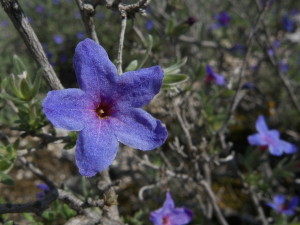 True blue flowers don’t happen every day, but when they do, their beauty is heart-stopping. A few years ago, my daughter, the queen of container growing, had a heart-stopping moment with Lithodora diffusa, a small, perennial, ground-covering plant with true blue flowers. She thought it was perfect for a mixed container arrangement. I thought it might be perfect for a whole host of garden uses.
True blue flowers don’t happen every day, but when they do, their beauty is heart-stopping. A few years ago, my daughter, the queen of container growing, had a heart-stopping moment with Lithodora diffusa, a small, perennial, ground-covering plant with true blue flowers. She thought it was perfect for a mixed container arrangement. I thought it might be perfect for a whole host of garden uses.
Anything so truly blue is likely part of the Boraginaceae or borage family, home to the culinary herb, borage, as well as other cerulean-flowered lovelies like forget-me-not, pulmonaria or lungwort, and Virginia bluebells. Lithodora is indeed a member of that blue-flowered clan. The blooms often perform in ways similar to those of their borage relations—appear somewhat pink in bud, but develop the characteristic blue hue when the flowers mature.
The name is lovely, springing from “lithos”—the classical Greek word for “stone”, and “dorea”, Greek for “gift”. In its native habitat in southwestern Europe, the Mediterranean and Turkey, lithodora grows in stony or rocky places on the edges of woodlands. It is certainly a gift to find such a beautiful thing amongst the rocks and brush. “Diffusa” comes from the same root as the English word “diffuse”, and refers to the crawling, prostrate habit.
So what does lithodora bring to the garden? Summer color–from late spring through August–provided by shrubby little plants that are six to 12 inches tall, with a spread of two or more feet. The flowers are borne on the ends of the hairy stems and have five petals apiece, united in a short tube at the base of each bloom. The slender leaves alternate on the stems, and also have a tendency to hairiness. This sounds unattractive, but the overall habit and the lovely flowers add up to an appealing presentation.
Some people grow lithodora as an annual, but the plants are perennial in USDA plant hardiness zones six through eight or nine. On the warmer end of that hardiness spectrum, the leaves may remain evergreen through the cold weather months. On the colder end, lithodora specimens should be well mulched in the fall to get them safely to spring.
One of the most popular lithodora varieties is ‘Grace Ward’, with deep blue flowers. ‘White Star’ is gorgeous, even if it is a misnomer. The base petal color is actually white, with a bright blue “star” in the middle of each blossom. ‘Heavenly Blue’ is another variety, but it is hard to tell from online pictures whether it is more or less blue than ‘Grace Ward’. ‘Alba’ is white, as the name suggests, but seems to be very difficult to find in this country.
The genus was first described in 1845, by August Heinrich Rudolf Grisebach, one of the many scientifically-minded nineteenth century Europeans who roamed the globe in search of new plants. Grisebach was a German doctor, whose interest in plants and plant classification eventually led him to become director of the botanical garden at Gottingen University. He traveled widely, and one of his destinations was Turkey, part of the native range of lithodora. No doubt he was as entranced by the blue flowers as my daughter was 175 years later.
In keeping with its name, lithodora works well in rock garden crevices, but is also a great “spiller”, either in large containers or atop stone walls. It is not a terribly formal-looking plant, but could be used in the front of garden beds. Since I am always looking for ways to disguise ripening bulb foliage, I can imagine planting it in beds that are also home to daffodils or other early to mid spring bloomers.
Generally speaking, lithodora is happy in full sun to part shade. Full sun works best in the north end of its climate range, while part shade will help the plants flourish in southern climates. The soil should be on the acid side of the pH scale and uniformly moist. As with many flowering plants, a haircut after bloom time will make the plant look better and possibly induce it to throw off a few more flowers in the fall.
Varmints of various types don’t care for lithodora, or, at least, like other plants better. Garden visitors will love it.
To lay hands on your own lithodora, try Bluestone Perennials, 7211 Middle Ridge Rd. Madison, OH 44057; (800) 852-5243; www.bluestoneperennials.com. Print catalog available.
